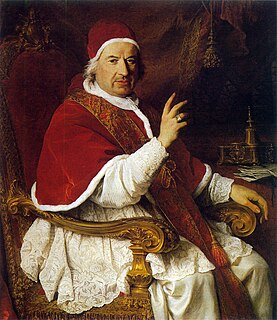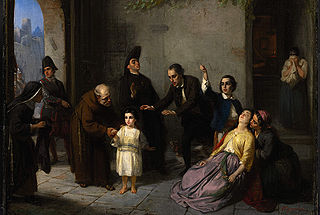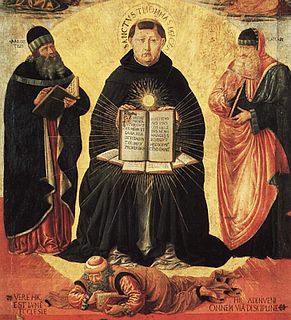Contents and background
Benedict set out several guidelines: [1] [2]
- it is generally not licit to baptize the child of a Jewish family without parental consent
- it is licit to baptize a Jewish child in danger of death without parental consent
- church authorities have a duty to remove a baptized child from its parents' custody if the parents have not been baptized and to provide the child with a Christian education, whether that child's baptism is licit or not.
Ecclesiastical authorities severely punished those who conducted illicit baptisms, but the fact that a baptism was illicit had no effect on the consequences of the baptism for church policy. Before this papal bull, Catholic theologians - including Thomas Aquinas, Duns Scotus, Guillaume Durand and Francisco Suárez - had also discussed these questions. [3] [4]
Postremo mense was addressed to Ferdinando Maria de' Rossi [ it ], the vicegerent of the Diocese of Rome. In 1747, a Catholic named Antonio Viviani had entered the Ghetto of Rome, to which the Jews of Rome were confined, and baptized the three daughters, the eldest of whom was nine, of Perla Misani. Having run out of holy water, he repeated the words of baptism over their 12-year-old brother while their mother was absent. De' Rossi noted five similar such cases that had occurred recently and sought guidance from Benedict, who observed that "every time this occurs, it is talked about as if it were the first time this has ever happened". [5] [6] [7] Benedict directed that the baptized children be removed from the custody of their Jewish parents unless the parents were willing to embrace Catholicism. Were the children to revert to Judaism they faced punishment as apostates. Benedict rejected the compromise position that baptized children be allowed to remain with their parents under precisely defined conditions. [4] He also determined that Jewish children aged seven or older who requested baptism could be licitly baptized and removed from their parents' custody. [8]
Assessment and impact
According to Kenneth Stow, "it is clear from the pope’s own words that he saw himself as building on traditions of centuries standing". Charles Ruch [ fr ] argues that Benedict gave
"un enseignement traditionnel, définitif et à peu près complet. Les principes sont, à la lettre, ceux qu’a posés saint Thomas [Aquinas]. Les conclusions sont empruntées aux décisions des papes et des conciles à l’enseignement commun des théologiens... Quelques cas nouveaux sont résolus; mais les réponses données s’harmonisent avec les solutions qu’avaient reçues les problèmes précédemment étudiés."
(a traditional, definitive and almost complete teaching. The principles are, to the letter, the same as those that Saint Thomas Aquinas laid down. The conclusions are taken from the decisions of popes and councils and follow the common teaching of theologians... some new cases are resolved; but the responses given harmonize with the solutions given to previously studied problems.)
Ruch notes that Benedict's teaching was subsequently endorsed by Doctor of the Church Saint Alphonsus Liguori, other theologians and the Sacred Congregation for the Propagation of the Faith. [9] [10] Indeed, Liguori, considering a similar possibility, writes, "Secondly, it is certain that if the parents abandon the faith to join the infidels, their children may be baptized, even if the parents object. Just as the Church has the power to coerce the parents to observe the faith, it may also take their children from them." [11]
Édouard Hugon writes, following Benedict, that baptized children become a "thing of the Church, they are joined to the body of the Church, and the Church obtains the right over them; and, that she might provide for their spiritual safety, she is able to separate them from their parents." [12] Cardinal Louis Billot considers the matter likewise. [13]
On 15 December 1751 Benedict issued Probe te meminisse, which discussed related questions and laid down punishments for Jewish converts who abandoned Catholicism after being baptized. [14]
The practice of removing children who had been baptized from their Jewish parents continued until the fall of the Papal States in 1870. Other Catholic states, such as Austria, had similar legal provisions. In 1858, Pope Pius IX cited Postremo mense when defending the church authorities who removed Edgardo Mortara from the custody of his Jewish parents on the grounds that the child had been baptized by a Christian servant and by law could only be raised in a Catholic household. Pius held that this was a divine duty imposed by the nature of baptism and that "we cannot" (non possumus) do otherwise. [15] [16]

Pope Benedict XIV, born Prospero Lorenzo Lambertini, was head of the Catholic Church from 17 August 1740 to his death in 1758.

Pope Leo VII was the bishop of Rome and nominal ruler of the Papal States from 3 January 936 to his death.

Pope Paul IV, C.R., born Gian Pietro Carafa, was head of the Catholic Church and ruler of the Papal States from 23 May 1555 to his death in 1559. While serving as papal nuncio in Spain, he developed an anti-Spanish outlook that later coloured his papacy. A part of the Papal States was invaded by Spain during his papacy and in response to this, he called for a French military intervention. To avoid a conflict at the same time of the Italian War of 1551–1559, the Papacy and Spain reached a compromise with the Treaty of Cave: French and Spanish forces left the Papal States and the Pope adopted a neutral stance between France and Spain.

The Mortara case was an Italian cause célèbre that captured the attention of much of Europe and North America in the 1850s and 1860s. It concerned the Papal States' seizure of a six-year-old boy named Edgardo Mortara from his Jewish family in Bologna, on the basis of a former servant's testimony that she had administered an emergency baptism to the boy when he fell ill as an infant. Mortara grew up as a Catholic under the protection of Pope Pius IX, who refused his parents' desperate pleas for his return, and eventually became a priest. The domestic and international outrage against the pontifical state's actions may have contributed to its downfall amid the unification of Italy.

A godparent, in many denominations of Christianity, is someone who bears witness to a child's christening and later is willing to help in their catechesis, as well as their lifelong spiritual formation. In the past, in some countries, the role carried some legal obligations as well as religious responsibilities. In both religious and civil views, a godparent tends to be an individual chosen by the parents to take an interest in the child's upbringing and personal development, to offer mentorship or claim legal guardianship of the child if anything should happen to the parents. A male godparent is a godfather, and a female godparent is a godmother. The child is a godchild.

As traditionally the oldest form of Christianity, along with the ancient or first millennial Eastern Orthodox Church, the non-Chalcedonian or Oriental Churches, and the Church of the East, the history of the Catholic Church is integral to the history of Christianity as a whole. It is also, according to church historian, Mark A. Noll, the "world's oldest continuously functioning international institution." This article covers a period of just under two thousand years

Pedro Martínez de Luna y Pérez de Gotor, known as el Papa Luna in Spanish and Pope Luna in English, was an Aragonese nobleman, who as Benedict XIII, is considered an antipope by the Catholic Church.

The sacraments of initiation are the three sacraments of Baptism, Confirmation and Eucharist. As such, they are distinguished from the Sacraments of healing and from the Sacraments of Service.
Valid but illicit and valid but illegal are descriptions applied in Catholic Church to an unauthorized celebration of a sacrament or an improperly placed juridic act that nevertheless has effect. Validity is presumed whenever an act is performed by a qualified person and includes those things which essentially constitute the act itself as well as the formalities and requirements imposed by law for the validity of the act.
The Sodality of Our Lady (also known as the Sodality of the Blessed Virgin Mary is a Roman Catholic Marian Society founded in 1563 by young Belgian Jesuit, Jean Leunis, at the Roman College of the Society of Jesus. The modern Ignatian lay group, Christian Life Community, traces its origins to the first Sodality.
Feeneyism is the doctrinal position which is associated with Leonard Feeney (1897–1978), a Jesuit priest and a founder of the Slaves of the Immaculate Heart of Mary, which advocated a strict interpretation of the doctrine extra Ecclesiam nulla salus.
An emergency baptism is a baptism administered to a person in danger of death. This can be done by a person not normally authorized to administer the sacraments.

This article contains a selection of thoughts of Thomas Aquinas on various topics. It is not intended as a complete account of Aquinas's thought. Within Aquinas' thought is included the philosophical school of Thomism.
The relations between Pope Pius IX and Judaism were off to a good start at the beginning of his papacy, but relations later soured after anti-clerical revolutions removed most of the pontiff's temporal power and he stiffened into intolerance. While Pius rejected charges of antisemitism, the rift created by the Mortara Affair undermined his moral authority in the eyes of some during the rest of his pontificate.
The Jewish orphans controversy was a dispute about the custody of Jewish children after the end of World War II. Some Jewish children had been baptized while in the care of Catholic institutions or individual Catholics during the war. Such baptisms allowed children to be identified as Catholics to avoid deportation and incarceration in concentration camps, and likely death in the Holocaust. After the end of hostilities, Catholic Church officials, either Pope Pius XII or other prelates, issued instructions for the treatment and disposition of such Jewish children, some but not all of whom were now orphans. The rules they established, the authority that issued those rules, and their application in specific cases is the subject of investigations by journalists and historians.

Believer's baptism is the Christian practice of baptism as is understood by many evangelical denominations, particularly those that descend from the Anabaptist and English Baptist tradition. According to their understanding, a person is baptized on the basis of his or her profession of faith in Jesus Christ and as admission into a local community of faith.
The relations between Pope John XXIII and Judaism are generally thought to have been among the best in the bi-millennial history of Christianity. The Pope initiated a policy of Christian–Jewish reconciliation after his election to the papacy in 1959, which focused on the Second Vatican Council producing a document on the relationship between the Catholic Church and the Jews. During his earlier career in the diplomatic service, especially during World War II, he had taken a series of actions that demonstrated his solidarity with victims of anti-Semitism.
The conversion of Jews to Catholicism during the Holocaust is one of the most controversial aspects of the record of Pope Pius XII during The Holocaust.

The following outline is provided as an overview of and topical guide to the Catholic Church:
Canon 844 is a Catholic Church canon law contained within the 1983 Code of Canon Law, which defines the licit administration and reception of certain sacraments of the Catholic Church in normative and in particular exceptional circumstances, known in canonical theory as communicatio in sacris.










